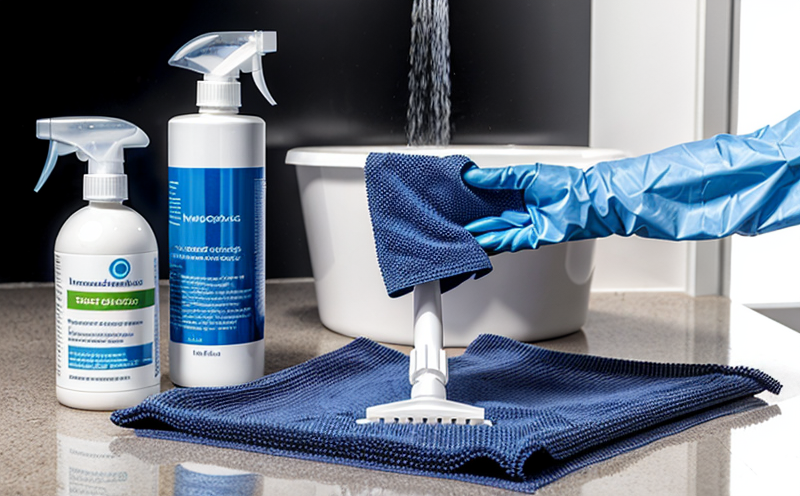DIN EN 14476 Virucidal Activity Testing of Hygiene Products with Nanomaterials
The DIN EN 14476 standard is a critical tool for ensuring the efficacy and safety of hygiene products that incorporate nanomaterials. This testing protocol specifically evaluates the virucidal activity of such products, which are designed to inactivate or destroy viruses upon contact. The use of nanomaterials in these products can enhance their performance significantly by providing increased surface area for virus interaction, improved stability at the application site, and enhanced antimicrobial properties.
Virucidal activity testing is essential because it ensures that hygiene products meet regulatory requirements and deliver effective protection against viral contamination. The standard specifies detailed procedures to ensure consistent and reliable results across different laboratories. By adhering to this protocol, manufacturers can demonstrate compliance with international standards and gain consumer confidence in the efficacy of their products.
The test involves exposing a specified amount of virus suspension to the product for a defined period under controlled conditions. Following exposure, the viral load is measured both before and after treatment. A reduction in viable viruses indicates that the product has virucidal activity. The degree of reduction can be quantified using logarithmic scales or percentage reductions, depending on the specific requirements of the standard.
Testing with nanomaterials adds complexity due to their unique properties and potential for aggregation. Proper sample preparation is crucial to ensure accurate results. This includes ensuring that the nanomaterials are uniformly distributed within the product matrix and that any potential interference with viral detection is minimized. The choice of virus strain, concentration, and incubation time is also critical as these factors can significantly influence test outcomes.
Instrumentation plays a vital role in this testing process. Laboratories equipped with advanced particle analysis tools, such as scanning electron microscopy (SEM) or transmission electron microscopy (TEM), can help verify the presence of nanomaterials within the product matrix. Spectroscopic techniques like X-ray diffraction (XRD) and Fourier-transform infrared spectroscopy (FTIR) are also used to confirm the chemical composition and structural integrity of the nanomaterials.
The acceptance criteria for DIN EN 14476 are stringent, ensuring that products meet rigorous standards. A minimum reduction in viral load is typically required, with higher thresholds often set for critical applications like medical devices or personal protective equipment (PPE). Compliance with these criteria not only ensures product efficacy but also contributes to public health and safety.
Given the importance of this testing, it is crucial that laboratories are accredited and adhere strictly to international standards. Accreditation bodies such as ISO/IEC 17025 or ENAC can provide assurance that laboratories meet the necessary quality requirements for accurate and reliable testing results. This accreditation process ensures that labs follow best practices in sample handling, data analysis, and reporting.
Understanding the specific requirements of DIN EN 14476 is essential for any organization involved in developing or manufacturing hygiene products with nanomaterials. Compliance not only enhances product performance but also helps organizations stay ahead of regulatory changes and consumer expectations.
Why It Matters
The efficacy of virucidal activity testing is paramount in the context of public health and safety, especially during times of viral outbreaks or pandemics. Ensuring that hygiene products containing nanomaterials are effective at reducing viral loads helps prevent the spread of infectious diseases. This is particularly important for products used in healthcare settings, households, and public spaces.
The use of nanomaterials in these products can lead to enhanced performance due to their small size and high surface area, which allows them to interact more effectively with viruses. However, this also means that the testing process must be meticulous to ensure accurate results. The standardization provided by DIN EN 14476 ensures consistency across different laboratories, allowing for reliable comparisons of product efficacy.
From a consumer perspective, knowing that their hygiene products meet stringent standards like DIN EN 14476 provides peace of mind and trust in the product's effectiveness. For healthcare providers and institutions, compliance with these standards can mean safer environments for patients and staff. The broader societal impact includes reduced transmission rates of infectious diseases, contributing to overall public health.
The importance of this testing cannot be overstated, especially given the increasing prevalence of viral strains that are resistant to traditional disinfectants. By leveraging nanomaterials and rigorous testing protocols like DIN EN 14476, manufacturers can develop innovative products that offer superior protection against a wide range of pathogens.
Why Choose This Test
- Precision in Results: Compliance with DIN EN 14476 ensures accurate and reliable testing results, which is critical for product efficacy.
- Regulatory Compliance: Ensures that hygiene products meet international standards and regulatory requirements.
- Innovation Support: Allows manufacturers to innovate by incorporating advanced nanomaterials into their products while ensuring effectiveness.
- Patient Safety: Provides a higher level of safety for patients, particularly in healthcare settings where infection control is paramount.
- Consumer Confidence: Builds trust with consumers who can rely on the efficacy and safety of tested products.
- Sustainable Development: Encourages the development of environmentally friendly and effective hygiene solutions.
Selecting this test guarantees that your products are not only innovative but also meet stringent international standards, ensuring they perform effectively in real-world applications. This approach helps manufacturers stay ahead in a competitive market while contributing to public health and safety.





